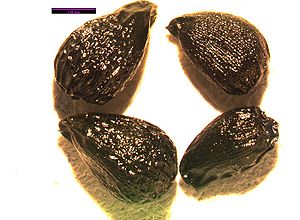Camassia quamash
First overview block: Camassia quamash, Liliaceae, English Names,Common camas, Small camas, Swamp sego
Contents
Taxonomy
Description
General: Scapose perennial from a deep-seated bulb, the scape 2-7 dm. tall. Leaves: Leaves several, all basal, 8-20 mm. broad, considerably shorter than the scape. Flowers: Inflorescence a raceme, many-flowered, 5-30 cm. long; pedicels 10-20 mm. long, spreading, arched or ascending in flower, incurved-erect in fruit; flowers pale to deep blue or violet, somewhat irregular; tepals 6, distinct, 15-35 mm. long and 2-8 mm. broad, narrowed at base, lowest segment curved outward and downward away from the others, all withering separately and exposing the ovary; stamens 6, anthers yellow or blue, style slender, stigmas 3. Fruit: Capsule ovoid, 3-celled, 1-2.5 cm. long. A bulbous plant with basal clusters of narrow, grass-like, bright green leaves. The flowering racemes are 1-3 ft. tall with dozens of showy, star-like, sky- to deep-blue flowers. Light to deep blue-violet, star-shaped flowers in a raceme; several narrow, grass-like leaves grow mostly near the base. The three sepals and three petals all share the blue color. This species is sometimes so frequent as to color entire meadows blue-violet. Indians pit-roasted the bland bulbs with other leaves, and also boiled them, which yielded a good syrup. Another similar species is Leichtlins Camas (C. leichtlinii), which grows only west of the Cascade Mountains, from southern British Columbia to the southern portion of Californias Sierra Nevada, and has radially symmetrical flowers.
Bloom Period
Distribution
Habitat
Distribution Both sides of the Cascades, British Columbia to California, east to Montana and Utah. Ecological Setting Open, moist areas, often where dry by late spring, at low to mid-elevations in the mountains.
Mesic to vernally moist meadows and grasslands in the lowland, steppe and montane zones (Douglas et al., 2001). Soil Texture Fine, medium or coarse soils Nutrients Nitrogen rich soils. Soil Reaction / Salinity 5.7-7.0 – no salinity tolerance, low CaCO3 tolerance pH 5.1 to 7.8 (Dave’s Garden, 2006). Moisture Regime High moisture use – no drought tolerance Shade Tolerance Shade-intolerant (Klinka et al., 1989). Successional Status In grasslands and meadows, it is most prevalent in initial and early seral communities, but also occurs in later seres.
Seral species on moist sites. Fire climax on drier sites (USDA, 2006).
Uses
Propagation
Photo Gallery
References
Seed
Abbreviation: CAQU
Seed sample from: 2011
Average Measurement: 2.8 x 1.8 x 1.8
Measurement Range: L: 2.5 - 3.3, W: 1.5 - 2, D: 1.5 - 2.25
Features
Shape: Narrow at hilum end, broadening out to a more rounded opposite end. CAQU slightly smaller than CALEI.
Color: Seeds black. Hilum more conspicuously contrasting seed color in CALEI than CAQU.
Surface: Seeds frequently pitted, glossy, and heavily wrinkled. CAQU tends to be more lustrous than CALEI. Seeds have a ridge that runs from hilum to opposite end.
Could be confused with: Camassia leichtlinii or Brodiaea coronaria
Latitudinal Cross Section: elliptical ![]()
Longitudinal Cross Section: obovate ![]()
Basic Explanations and Assumptions:
The dimensions for the seeds are length x width x depth. The location of the hilum is used as the base of the seed, and the length is measured from hilum to the opposite apex. Where a style is present, the length is measured from the hilum to the bottom of the style. Width is measured at a right angle to the length at the widest part. Depth is measured at a right angle to the intersection of height and width lines.
Measurements included are the mean average for each measurement of ten separate seeds.
All measurements in millimeters unless otherwise noted.

